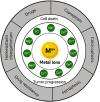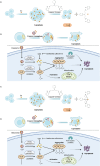The role of metal ions in the occurrence, progression, drug resistance, and biological characteristics of gastric cancer
- PMID: 38370477
- PMCID: PMC10869614
- DOI: 10.3389/fphar.2024.1333543
The role of metal ions in the occurrence, progression, drug resistance, and biological characteristics of gastric cancer
Abstract
Metal ions exert pivotal functions within the human body, encompassing essential roles in upholding cell structure, gene expression regulation, and catalytic enzyme activity. Additionally, they significantly influence various pathways implicated in divergent mechanisms of cell death. Among the prevailing malignant tumors of the digestive tract worldwide, gastric cancer stands prominent, exhibiting persistent high mortality rates. A compelling body of evidence reveals conspicuous ion irregularities in tumor tissues, encompassing gastric cancer. Notably, metal ions have been observed to elicit distinct contributions to the progression, drug resistance, and biological attributes of gastric cancer. This review consolidates pertinent literature on the involvement of metal ions in the etiology and advancement of gastric cancer. Particular attention is directed towards metal ions, namely, Na, K, Mg, Ca, Fe, Cu, Zn, and Mn, elucidating their roles in the initiation and progression of gastric cancer, cellular demise processes, drug resistance phenomena, and therapeutic approaches.
Keywords: calcicoptosis; cuproptosis; drug resistance; ferroptosis; gastric cancer; metal ion.
Copyright © 2024 Xiao, Li, Liu, Gao, Liang, Liu and Yang.
Conflict of interest statement
The authors declare that the research was conducted in the absence of any commercial or financial relationships that could be construed as a potential conflict of interest.
Figures







References
-
- Al C. S. A. H. K. F. K. S. T. T. E., Hagiwara A., Fukuda K., Shimomura K., Takagi T., Kin S., et al. (2003). Possible involvement of inositol 1,4,5-trisphosphate receptor type 3 (IP3R3) in the peritoneal dissemination of gastric cancers. Anticancer Res. 23, 3691–3697. - PubMed
-
- Almasi S., Kennedy B. E., El-Aghil M., Sterea A. M., Gujar S., Partida-Sánchez S., et al. (2018). TRPM2 channel-mediated regulation of autophagy maintains mitochondrial function and promotes gastric cancer cell survival via the JNK-signaling pathway. J. Biol. Chem. 293 (10), 3637–3650. 10.1074/jbc.M117.817635 - DOI - PMC - PubMed
Publication types
LinkOut - more resources
Full Text Sources

